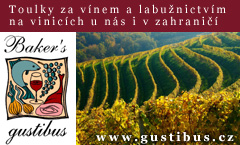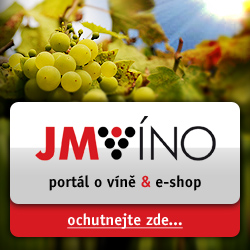Programme: Saturday 21.1. 06 - depart PRG arrival London STN 11h40, accommodation at Radisson SAS, wine tasting at the hotel bar with "wine angels", dinner. 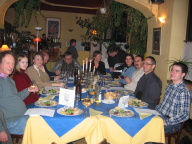 Sunday 22.1.06 - arrival Perpignan PGF, transfer to Domaine Hylari in Estagel and Tautavel. Gourmet dinner at Charmotel Graves, accommodation at a typical Catalan "mas" (hamlet) Mas Peychonnier. Sunday 22.1.06 - arrival Perpignan PGF, transfer to Domaine Hylari in Estagel and Tautavel. Gourmet dinner at Charmotel Graves, accommodation at a typical Catalan "mas" (hamlet) Mas Peychonnier.
Monday 23.1.06 - excursion to Quéribus (Cathar castle) and to Cucugnan. Visit to Cellier du Cucugnan, tasting, lunch at La Table du Curé, transfer to Maury, visiting Domaine de la Serre and dinner at Jean Pla's La Grande Table des Petits Plaisirs with appropriate tastings. Tuesday 24.1.06 - visiting Caveau Arnaud de Villeneuve at Rivesaltes, Château Caladroy in Bélesta de la Frontière and Cellier Trémoine in Rasiguères - village made famous by a British painist Moura Lympany. Dinner at Auberge des Capitelles in Cassagnes.
Wednesday departure from Perpignan-Rivesaltes airport via London. More on the region of Fenouillèdes and Côtes du Roussillon - see hereunder (a translation of an article published recently in the "Vinaøský obzor" magazine):
Fenouillèdes, Maury and Côtes du Roussillon-Villages
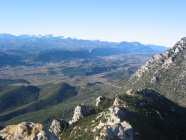 For some time I have been receiving invitations to visit the region from the association of Vignerons des Fenouillèdes based around the wine towns of Maury, Estagel, Tautavel, Latour de France, Maury, Bélesta de la Frontière, Rasiguères, Planèzes, Caramany, Lesquerdes, Saint Paul de Fenouillet and others, and named after the mountain range set in the Pyrenean foothills inland from Perpignan. This region straddles the old border (up till 16th century) between Catalunya (in the form of the kingdom of Aragon) and France. Technically Estagel is in Catalunya and Maury Occitan France. Last January we finally found time and flew in via London on the daily Perpignan (Perpinyà in Catalan) Ryanair flight which was as usual rather full, not only with French but second-homers from the UK. Thanks to low-cost air travel a journey such as this can now be undertaken more or less at will, whereas previouly only a lengthy car journey or very expensive Air France or TGV would get you there. For some time I have been receiving invitations to visit the region from the association of Vignerons des Fenouillèdes based around the wine towns of Maury, Estagel, Tautavel, Latour de France, Maury, Bélesta de la Frontière, Rasiguères, Planèzes, Caramany, Lesquerdes, Saint Paul de Fenouillet and others, and named after the mountain range set in the Pyrenean foothills inland from Perpignan. This region straddles the old border (up till 16th century) between Catalunya (in the form of the kingdom of Aragon) and France. Technically Estagel is in Catalunya and Maury Occitan France. Last January we finally found time and flew in via London on the daily Perpignan (Perpinyà in Catalan) Ryanair flight which was as usual rather full, not only with French but second-homers from the UK. Thanks to low-cost air travel a journey such as this can now be undertaken more or less at will, whereas previouly only a lengthy car journey or very expensive Air France or TGV would get you there.
We were met by Jean-Michel Hylari, our host and a medium-small wine maker from the town of Estagel. By the time we were ready to depart our plane had already flown off, such is the speed of low-cost. After lodging at the Charmotel les Graves we were shown his vineyards and two cellars,  where we tasted barrel samples of unblended reds - Syrah, Mourvèdre, Grenache Noir and Carignan from vieilles vignes (old vines). Also of particular interest were the Muscats de Rivesaltes and fortified VDN de Rivesaltes (which is fortified despite its name as Sweet Natural Wine). Another speciality of the house is Rancio, which is unfortified and made only in exceptional years from late-harvested grapes (November). This is made by purposefully oxidising or maderising the wine by placing it in small barrels in the hot summer sun. This procedure gives the wine a tawny color and a rich, unique flavor, naturally very high in alcohol and similar to Madeira, tawny Port or Marsala. Rancio wines are made throughout Spain, as well as in southern France and are usually sipped as an apéritif. Since French wine laws will not allow the term Vendange Tardive (late harvest) to be used anywhere except in Alsace, where, unlike where we tasted barrel samples of unblended reds - Syrah, Mourvèdre, Grenache Noir and Carignan from vieilles vignes (old vines). Also of particular interest were the Muscats de Rivesaltes and fortified VDN de Rivesaltes (which is fortified despite its name as Sweet Natural Wine). Another speciality of the house is Rancio, which is unfortified and made only in exceptional years from late-harvested grapes (November). This is made by purposefully oxidising or maderising the wine by placing it in small barrels in the hot summer sun. This procedure gives the wine a tawny color and a rich, unique flavor, naturally very high in alcohol and similar to Madeira, tawny Port or Marsala. Rancio wines are made throughout Spain, as well as in southern France and are usually sipped as an apéritif. Since French wine laws will not allow the term Vendange Tardive (late harvest) to be used anywhere except in Alsace, where, unlike 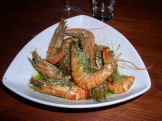 in the Czech Republic, it means precisely what it says, late picked, it has to be labelled as VDN Rivesaltes AOC. Dinner for the visiting journalists was in the hotel and started with goose liver foie gras downed with Muscat de Noël which is a young fortified Muscat released in time for the Christmas festivities. Wild boar ragú with home made pasta followed, accompanied by Côtes du Roussillon red, aged in oak. in the Czech Republic, it means precisely what it says, late picked, it has to be labelled as VDN Rivesaltes AOC. Dinner for the visiting journalists was in the hotel and started with goose liver foie gras downed with Muscat de Noël which is a young fortified Muscat released in time for the Christmas festivities. Wild boar ragú with home made pasta followed, accompanied by Côtes du Roussillon red, aged in oak. The Fenouillèdes weather in January is normally mild, unless the tramontana wind is blowing, with daytime temperatures around 12 °C, though at night they they drop and can well be below freezing. Luckily our first day was one of beautiful sunshine, for we were going to be taken to visit the  imposing and almost invisible ruin of the château Quéribus, 728 metres high and blending into the rocks between Estagel and Maury where it commands the Grau de Maury pass and plains of Roussillon below. From here one can see the Pyrenean peaks, the dominant local landmark the Pic du Canigou, the Fenouillèdes, the Mediterranean sea and lots of vineyards. The first mention of the castle dates from 1020 and the fortress became the last bastion of the Occitans to fall in the bloody crusade conducted by French kings against the "heretic" Cathars, in 1255. imposing and almost invisible ruin of the château Quéribus, 728 metres high and blending into the rocks between Estagel and Maury where it commands the Grau de Maury pass and plains of Roussillon below. From here one can see the Pyrenean peaks, the dominant local landmark the Pic du Canigou, the Fenouillèdes, the Mediterranean sea and lots of vineyards. The first mention of the castle dates from 1020 and the fortress became the last bastion of the Occitans to fall in the bloody crusade conducted by French kings against the "heretic" Cathars, in 1255.  Visits were undertaken to some of the modern new wineries that are springing up, such as Les Vignes d'Élodie and Domaine de la Serre in the small town of Maury, with its typical narrow streets filled with charging lorries, both making normal reds and whites, as well as AC Maury. Maury is a very small appellation for fortified reds coming from the area surrounding the town exclusively for fortified red wines made from Grenache Noir grapes. Any other wines from here come under the Côtes du Roussillon denomination. Also interesting is the excellent vinothèque in Maury, Fenouillèdes Selection, which is run by Jean Pla, along with Hylari, another of the leading lights in the local winemaking scene. This establishment has a representative selection of most of the finest wineries in the region selling wines at ex-cellar prices. Visits were undertaken to some of the modern new wineries that are springing up, such as Les Vignes d'Élodie and Domaine de la Serre in the small town of Maury, with its typical narrow streets filled with charging lorries, both making normal reds and whites, as well as AC Maury. Maury is a very small appellation for fortified reds coming from the area surrounding the town exclusively for fortified red wines made from Grenache Noir grapes. Any other wines from here come under the Côtes du Roussillon denomination. Also interesting is the excellent vinothèque in Maury, Fenouillèdes Selection, which is run by Jean Pla, along with Hylari, another of the leading lights in the local winemaking scene. This establishment has a representative selection of most of the finest wineries in the region selling wines at ex-cellar prices.
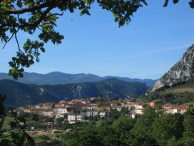 The soils here are schistous, summers are very hot and extremely dry. After the 2nd World War the trend was toward fortified wines, such as (e.g. fortified wines similar to ruby port, such as Banyuls, Rivesaltes, Maury), although nowadays with health-conscious customers on the increase, plantings The soils here are schistous, summers are very hot and extremely dry. After the 2nd World War the trend was toward fortified wines, such as (e.g. fortified wines similar to ruby port, such as Banyuls, Rivesaltes, Maury), although nowadays with health-conscious customers on the increase, plantings 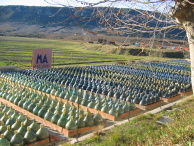 are fewer. Many vineyards have been upgraded with modern young winemakers moving in, even from Holland and the UK, moving into the region seeing its great promise. Then there are the big names (e.g. Depardieu, Magrez, Chapoutier, Lurton and Calvet-Thunevin, whose wines sell at 30+ Euros a bottle). Traditional wineries (Mas Amiel, the most famous in the area, and Château Caladroy in Bélesta de la Frontière and Château Dona Baissas) only deal in to quality production, while biodynamic growers and producers (Gauby, Séguéla, which also fetch premium prices), are basking in success. are fewer. Many vineyards have been upgraded with modern young winemakers moving in, even from Holland and the UK, moving into the region seeing its great promise. Then there are the big names (e.g. Depardieu, Magrez, Chapoutier, Lurton and Calvet-Thunevin, whose wines sell at 30+ Euros a bottle). Traditional wineries (Mas Amiel, the most famous in the area, and Château Caladroy in Bélesta de la Frontière and Château Dona Baissas) only deal in to quality production, while biodynamic growers and producers (Gauby, Séguéla, which also fetch premium prices), are basking in success.
A visit to the cellars Vignobles de Rivesaltais, a massive wine coop, run by Fernand Baixas whom I have known from the wine competition Vinalies Internationales in Paris, proved  most instructive. This coop comprises 3,000 ha vineyards comprising over 500 growers, 60 ful-time employees dealing with 20 different varieties, making some 130,000 hl and 3 million bottles annually. Much of the production is sold from the barrel and one may have expected only average quality on the Vin de Pays level, but the tasting began with a range of local VdP and Côtes du Roussillon varietal wines - Chardonnay, Viognier, Merlot and Cab Sauv, fresh, clear, young, and at reasonable prices before we progressed to the Muscats de Rivesaltes, then finally the VDN Rivesaltes. Amber-hued Ambré or Tuilé from 5.30 Euros and finally vintages from 2001 to 1973, which they sell for 29.65 Euros. Much of this wine type of is exported, not just to Europe, but to markets such as Russia, China, USA and now Japan, where it is proving very popular. These wines have a deep orange colour, thick lush fruit on the tone, with the 1977 going into amber. As a special occasion our host then sent for a 1932 the same year as the coop was founded. Unfortunately this is not for sale, only being offered to VIP guests. This was as fresh as ever with a deep orange colour, an opulent nose evoking dried-fruit, strong notes of cognac and walnuts, and a very long caramel finish. most instructive. This coop comprises 3,000 ha vineyards comprising over 500 growers, 60 ful-time employees dealing with 20 different varieties, making some 130,000 hl and 3 million bottles annually. Much of the production is sold from the barrel and one may have expected only average quality on the Vin de Pays level, but the tasting began with a range of local VdP and Côtes du Roussillon varietal wines - Chardonnay, Viognier, Merlot and Cab Sauv, fresh, clear, young, and at reasonable prices before we progressed to the Muscats de Rivesaltes, then finally the VDN Rivesaltes. Amber-hued Ambré or Tuilé from 5.30 Euros and finally vintages from 2001 to 1973, which they sell for 29.65 Euros. Much of this wine type of is exported, not just to Europe, but to markets such as Russia, China, USA and now Japan, where it is proving very popular. These wines have a deep orange colour, thick lush fruit on the tone, with the 1977 going into amber. As a special occasion our host then sent for a 1932 the same year as the coop was founded. Unfortunately this is not for sale, only being offered to VIP guests. This was as fresh as ever with a deep orange colour, an opulent nose evoking dried-fruit, strong notes of cognac and walnuts, and a very long caramel finish. 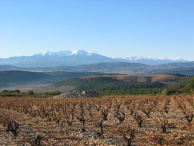 Many of the coop's premium fortified wines bear the name Arnaud de Villeneuve (Arnau de Vilanova in Catalan) who was a native of Valencia in the Spanish part of Catalunya in the 13th century. Originally the court doctor to the Aragonese king and later the itinerant medic in many European courts during a long and varied career. As a great wine lover as well as a believer in the medicine of the ancients which relied heavily on the use of wine and other alcoholic concoctions, he would later also revolutionise oenology, adopting the pot still early in his career initially for the purpose of perfecting his beauty products for courtly ladies. He made many discoveries through use of pure alcohol, which he introduced into wines, to extend their medicinal powers as well as improve their quality by immediately stopping fermentation and increasing the alcohol level while leaving very considerable natural sugar in the wines. He is celebrated in Roussillon for his work in "inventing" fortification, much in the way Dom Pérignon is in Champagne for his bubbles (although in the latter case the good monk was actually trying to stop secondary fermentation not encourage it). So much for history. Many of the coop's premium fortified wines bear the name Arnaud de Villeneuve (Arnau de Vilanova in Catalan) who was a native of Valencia in the Spanish part of Catalunya in the 13th century. Originally the court doctor to the Aragonese king and later the itinerant medic in many European courts during a long and varied career. As a great wine lover as well as a believer in the medicine of the ancients which relied heavily on the use of wine and other alcoholic concoctions, he would later also revolutionise oenology, adopting the pot still early in his career initially for the purpose of perfecting his beauty products for courtly ladies. He made many discoveries through use of pure alcohol, which he introduced into wines, to extend their medicinal powers as well as improve their quality by immediately stopping fermentation and increasing the alcohol level while leaving very considerable natural sugar in the wines. He is celebrated in Roussillon for his work in "inventing" fortification, much in the way Dom Pérignon is in Champagne for his bubbles (although in the latter case the good monk was actually trying to stop secondary fermentation not encourage it). So much for history.
|


